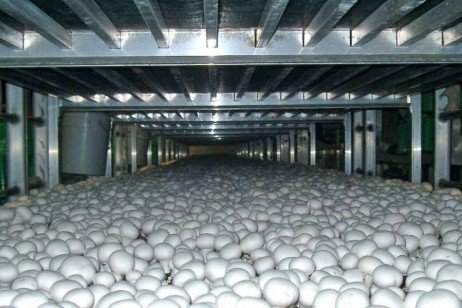Six Steps to Mushroom Farm

Mushroom Farm cultivating comprises of six stages, and albeit the divisions are to some degree discretionary, these means distinguish what is expected to frame a creation framework.
Prelude
The second release of Six Steps to Mushroom Farming perceives that much advancement in mushroom cultivating has occurred throughout the most recent a long time since the first version was distributed. Patterns, for example, utilization of constrained air circulation Phase I, Phase II mass produce run, packaging inoculum, manure supplementation, half and halves, worked on nourishing status of mushrooms, and elective employments of post crop mushroom fertilizer requires a refreshed, rearranged, and extended second release of Six Steps to Mushroom Farming.
1. Stage I: Making Mushroom Compost
Stage I fertilizing the soil is started by blending and wetting the fixings as they are stacked in a rectangular heap with tight sides and a free community. Regularly, the mass fixings are put through a manure turner. Water is showered onto the pony fertilizer or manufactured manure as these materials travel through the turner. Nitrogen enhancements and gypsum are spread over the highest point of the mass fixings and are totally blended by the turner.
When the heap is wetted and framed, oxygen consuming maturation (fertilizing the soil) initiates because of the development and multiplication of microorganisms, which happen normally in the mass fixings. Hotness, smelling salts, and carbon dioxide are delivered as results during this interaction. The utilization of constrained air circulation, where the manure is set on a substantial floor or in passages or fortifications and circulated air through by the constrained entry of air by means of a plenum, spouts or nozzles situated in the floor has become almost all inclusive in the mushroom business.
Mushroom fertilizer creates as the substance idea of the crude fixings is changed over by the movement of microorganisms, hotness, and some hotness delivering compound responses. These occasions bring about a food source generally appropriate for the development of the mushroom to the avoidance of different growths and microorganisms. There should be sufficient dampness, oxygen, nitrogen, and sugars present all through the interaction, or, more than likely the cycle will stop. This is the reason water and enhancements are added occasionally, and the fertilizer heap is circulated air through as it travels through the turner.
2. Stage II: Finishing the Compost
There are two significant purposes to Phase II treating the soil. Purification is important to kill any creepy crawlies, nematodes, bug parasites, or different vermin that might be mushroom farm available in the fertilizer. Furthermore, second, it is important to condition the manure and eliminate the smelling salts that shaped during Phase I treating the soil. Alkali toward the finish of Phase II in a fixation higher than 0.07 percent is frequently inhibitory to mushroom bring forth development, in this way it should be eliminated; for the most part, an individual can smell smelling salts when the focus is above 0.10 percent.
Stage II happens in one of three spots, contingent upon the sort of creation framework utilized. For the drafted process for developing, fertilizer is stuffed into wooden plate, the plate are stacked six to eight high, and are moved into an ecologically controlled Phase II room. From that point, the plate are moved to uncommon rooms, each intended to give the ideal climate to each progression of the mushroom developing cycle.
With a bed or rack framework, the fertilizer is put straightforwardly in the beds, which are in the room utilized for all means of the yield culture. The most as of late presented framework, the mass framework, is one in which the fertilizer is put in a protected passage with a punctured floor and PC controlled air circulation; this is a room explicitly intended for Phase II treating the soil.
3. Bringing forth
As a mushroom develops, it produces a huge number of infinitesimal spores on mushroom gills covering the underside of a mushroom cap. These spores work generally like the seeds of a higher plant. In any case, producers don’t utilize mushroom spores to ‘seed’ mushroom manure since they develop unusually and along these lines, are not dependable. Luckily, mycelium (slender, string like cells) can be engendered vegetatively from developed spores, permitting generate creators to increase the way of life for bring forth creation. Particular offices are needed to engender mycelium, so the mushroom mycelium stays unadulterated. Mycelium engendered vegetatively on different grains or agars is known as produce, and business mushroom ranchers buy bring forth from organizations spend significant time in its production.
Produce creators start the generate making process by disinfecting a combination of millet grain in addition to water and chalk; rye, wheat, and other little grain might be fill in for millet. Cleaned horse excrement framed into blocks was utilized as the development mode for produce up to around 1940, and this was called square or block bring forth, or fertilizer generate; such generate isn’t utilized today. When disinfected grain has a touch of mycelium added to it, the grain and mycelium is shaken multiple times at 4-day stretches over a 14-day time of dynamic mycelial development. When the grain is colonized by the mycelium, the item is called bring forth (Fig. 3). Generate can be refrigerated for a couple of months, so bring forth is made ahead of an armer’s organization for produce.
3.1 Supplementation at producing
In the mid 1960s, yield increments were seen when fertilizer was enhanced with protein as well as lipid rich materials at producing, packaging and later. Up to a 10% increment in yield was gotten when modest quantities of protein supplements were added to the manure at producing. Unnecessary warming and incitement of contender molds in the manure considerably restricted the measure of supplement and comparing advantage that could be accomplished. It was these limits that were overwhelmed by the creation of postponed discharge supplements for mushroom culture (Carroll and Schisler 1976).
The burdens related with the supplementation of non-treated the soil supplements to mushroom manure at bringing forth were to a great extent defeat by typifying miniature drops of vegetable oil inside a protein cover that was denatured with formaldehyde. Increments of as much as 60% were acquired. Today, a few business supplements are accessible that can be utilized at producing or at packaging to animate mushroom yield.
4. Packaging
Packaging is a top-dressing applied to the bring forth run manure on which the mushrooms at last structure. A combination of peat greenery with ground limestone can be utilized as packaging. Packaging needn’t bother with supplements since packaging goes about as a water repository and where rhizomorphs structure. Rhizomorphs look like thick strings and structure when the extremely fine mycelium melds. Mushroom initials, primordia, or pins structure on the rhizomorphs, so without rhizomorphs there will be no mushrooms.
Packaging ought to have the option to hold dampness since dampness is fundamental for the advancement of a firm mushroom. The main elements of the packaging layer are providing water to the mycelium for development and improvement, shielding the fertilizer from drying, offering help for the creating mushrooms and opposing underlying breakdown following continued watering. Providing however much water as could be expected to the packaging as ahead of schedule as conceivable without draining into the basic fertilizer gives the best yield potential.
Sphagnum peat greenery is the most regularly utilized material for packaging. Sphagnum can go from brown (youthful, less disintegrated, free finished, surface peat) to dark (minimal, more decayed, profound burrowed) and might be handled contrastingly at the gather site. Processed peat is somewhat dried prior to bundling and transport while wet-dove peat is shipped in a soaked structure. A few cultivators incline toward wet-burrowed peat in view of the greater water holding limit contrasted with processed peat.
5. Sticking
Mushroom initials create after rhizomorphs have framed in the packaging. The initials are tiny yet can be viewed as outgrowths on a rhizomorph. When an underlying quadruples in size, the design is a pin. Pins proceed to extend and become bigger through the button stage, and at last a button augments to a mushroom (Fig. 5). Harvestable mushrooms seem 18 to 21 days subsequent to packaging. Pins foster when the carbon dioxide content of room air is brought down to 0.08 percent or lower, contingent upon the cultivar, by bringing natural air into the developing room. Outside air has a carbon dioxide content of around 0.04 percent.
6. Editing
The terms flush, break, or sprout are names given to the rehashing 3-to 5-day reap periods during the editing cycle; these are trailed by a couple of days when no mushrooms are free to gather. This cycle rehashes the same thing in a cadenced manner, and collecting can happen insofar as mushrooms keep on developing. Most mushroom ranchers gather for 35 to 42 days, albeit some collect a yield for 60 days, and reap can continue for up to 150 days.
Air temperature during editing ought to be held between 57° to 62°F for great outcomes. This temperature range favors mushroom development, yet cooler temperatures can stretch the existence patterns of both illness microorganisms and bugs. It might appear to be odd that there are irritations that can harm mushrooms, yet no harvest is developed that doesn’t need to contend with different living beings.
Mushroom nuisances can cause absolute yield disappointments, and regularly the central consideration on how long to gather a harvest depends fair and square of vermin pervasion. These microbes and creepy crawlies can be constrained by social practices combined with the utilization of pesticides, however it is generally alluring to prohibit these creatures from the developing rooms.





